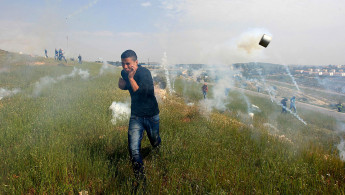Land Day: an existential conflict
Analysis: Palestinians commemorated Land Day on 30 March amid gloomy prospects that are likely to see more of their land seized by Israel.
5 min read
Palestinian protestors during clashes with Israeli security forces over land [Anadolu]
This Monday, Palestinians in the occupied Palestinian territories commemorated the 39th Land Day under gloomy circumstances over what is left of their land.
The past two decades, especially after the Oslo Accords, have seen a revival of the Palestinian national movement, with the establishment of the National Democratic Assembly. This helped eliminate the risks of Israelisation and the tarnishing of the Palestinian identity that came with the signing of the Oslo Accords.
However, this period also saw an encroachment of Zionist extremism among the traditional Israeli left wing, which has veered further right than the right wing has moved to the centre.
The results of the recent Israeli elections on 17 March, along with the accompanying right wing alignments on the one hand, and the alliances uniting the historic Labour Party and Likud descendant Tzipi Livni in a new list confirming their common Zionist grounds on the other, reflected the size and scope of Israel's rightward shift.
This shift is not only a result of the so-called "demographic factor" - fears among Jewish Israelis about the population growth of Palestinian citizens - but also the political decision, represented by the formation of the Zionist Camp alliance, and a collective Zionist discourse calling for the exclusion of Palestinian citizens from any government or political coalition, even if it is temporary or from outside the government coalition.
These shifts in discourse, practice and statements show how Israel continues to hold on to the fundamentals of Zionism, and its historic slogan to secure the largest area of land with the least number of non-Jews. This continues to be the basis by which Israel and its parties deal with Palestinian citizens of Israel.
Since the 1948 Nakba, through a series of different laws and administrative procedures, the occupation has managed to seize control of 96.4 percent of historic Palestinian land within the pre-Nakba borders, leaving Palestinians with less than 3.6 percent. However, the occupation still seeks to take the remaining land, particularly in the Negev, through the Prawer Plan (a bill on the Arrangement of Bedouin Settlement in the Negev), which seeks to seize roughly 1.2 million dunums of land from Palestinians there. Israel claims these lands are contested and that Palestinians are unable to provide proof of ownership.
| The occupation has managed to seize control of 96.4 percent of the historic Palestinian land within pre-Nakba borders. |
Through this plan, which has failed over the past two years, and particularly through a series of rallies and violent clashes in Galilee, the Triangle and the Negev in 2014, Israel seeks to displace nearly 40,000 Palestinians who live in over 30 pre-Nakba Negev villages, which Israeli authorities refuse to recognise so it can expel its people and use their lands to develop the Negev.
Even though the Joint Arab List, as well as the Democratic Front (a Jewish-Palestinain communist party), won 13 seats in recent elections, it would be unrealistic to think that if it only depended on parliamentary activity the List would be able to prevent the passing of a new bill. Any draft bills proposed by the List would face majority opposition by the Knesset's Zionist parties, unless it supported its proposals with popular activity.
Following the formation of the new government, Palestinian citizens of Israel will clearly face a series of racist bills relating to land that prevent the return of confiscated land or even allow them to receive new land from the state.
In addition, a new policy is to build country projects, particularly on the remaining Arab lands, in an approach adopted by Israel after the first Land Day in 1976. The same happened when Israel built the highway from the Negev to Galilee on Palestinian lands. There are also ongoing plans to expand and develop railroads that will consume a large part of remaining Palestinian lands.
While Arab citizens of Israel find themselves besieged in their towns and villages by military zones or national parks and natural reservations, the new government bears signs of a fierce war over the remaining lands particularly in the Negev, if Avigdor Lieberman takes over the Ministry for the Development of the Negev and Galilee.
In addition, more Jewish settlements are being built in Galilee, especially following the approval of the Admission Committees Law, which allows new settlements to reject the admission of Arab families under the pretext of "cultural specificity".
On the 39th Land Day, land remains the focus of the conflict with Israel, but not only in Israeli territory. If the new government includes Jewish Home leader Naftali Bennett there will be new schemes, including a law to merge Zone C in the West Bank and apply Israeli law there (on land without residents), meaning it will take over 61 percent of the West Bank. Unlike Palestinians, Israel seems to hold on to its main principle that whoever owns the land controls it by land and air, and owns the keys to economic development and construction. These are key in a conflict considered existential by Israel, but which Palestinians consider to be over borders.
While Israel is "stingy" and holds on to every inch of settlements even considered illegal by Israeli law, Arabs have generously offered their tacit consent to allow Israel to keep its foot in the door through settlement blocs in the West Bank.
This article is an edited translation from our Arabic edition.
Opinions expressed in this article remain those of the author and do not necessarily reflect those of al-Araby al-Jadeed, its editorial board or staff.





 Follow the Middle East's top stories in English at The New Arab on Google News
Follow the Middle East's top stories in English at The New Arab on Google News


